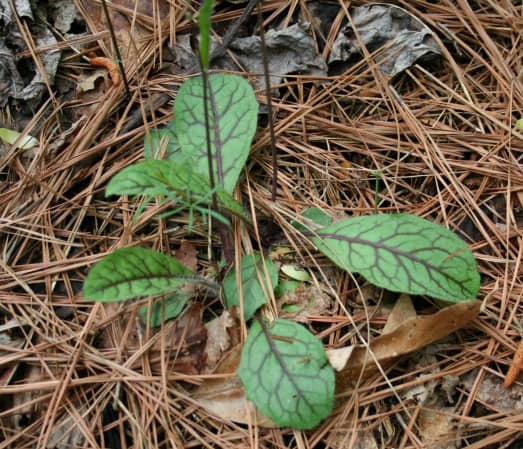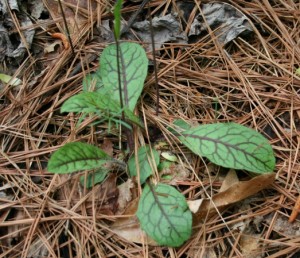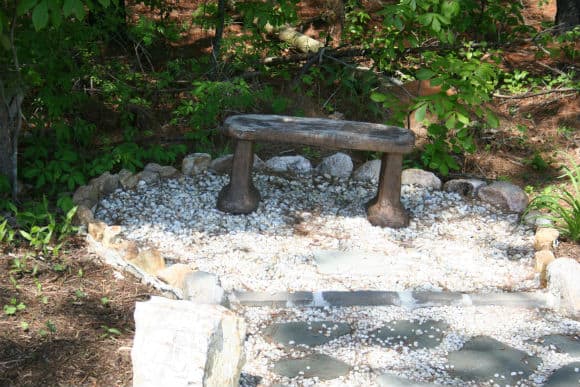Every once in a while, I fall in love…with a weed.
That’s what happened this week with Hieracium venosum (Rattlesnake weed).
My compost pile is on the edge of the woods, tucked under the rise of the hill that encompasses the perennial garden. I also dump weeds and other debris from the garden in piles along the path leading to the compost pile, so it’s a fairly well-trafficked pathway in our woods. It was originally an access path leading into the tree plantings for our loblolly pine farm.
I noticed the lush vegetation springing to life along the sides of the pathway. After each rainfall, it seemed that more and more weeds arose from the rubbish. But what is a weed? Should these plants be properly called wildflowers – or weeds?
There tucked under a decaying tree trunk was a flush of new growth, ferns peeking up from under the leaf mulch. Across the way, vinca stretched her tendrils across the pathway, criss-crossing with various other vines. Honeysuckle vines, the scourge of farms everywhere, twine about the shrubs, promising me the delights of their heady perfume in the weeks to come.
As I passed these delights, carrying my little pail of sticky coffee grounds, stinky banana peels and smushy lettuce to the compost pile, I noticed this little fellow:
The picture doesn’t do it justice. The soft, slightly furred leaves have a lovely pattern of burgundy like lace against the silver-green foliage. The stems are burgundy, too, and the flower stalks unfurling from the central whorl of each plant. A cluster of them grew at the edge of the path where the main pathway intersected with the path to the compost pile, barely visible above the clutter of pine needles guarding its secret habitat. I had to brush away pine needles to reveal the splendor of the little weed.
This little weed called to me. There was something about it that just “spoke” to me, that made me stop and take notice. After two days of this, I said aloud, “Okay, okay! I will add you to my garden!”
And that’s what I did.
Out came the pail and the trowel. I dug up six of the little plants, carefully scooping enough sandy forest soil so that they might feel at home in their new habitat. I added them to the shade garden near the meditation bench in the back of the garden where forest ferns, transplanted from paths that would be mown (thus destroying the ferns) have taken root, and vinca from the forest floor mingles with cultivated lily of the valley, day lilies, butterfly bushes, and some stray lilies the deer haven’t yet found.
After transplanting and watering my new friends, I set out on a quest to identify them online. And that’s where I was stumped. I couldn’t figure out how to look up my little plants. Most wildflower and weed database show the flowers – of course they would. That’s the prettiest part of most plants. But these little guys had such adorable foliage, and they weren’t flowering yet. So how could I find them?
Two friends on Facebook came to the rescue. Kathleen is a new acquaintance, an herbalist and a plant person who immediately identified my plant as rattlesnake weed. Cynthia, a local friend and native plant enthusiast, confirmed it. A name led me to more information on this valuable weed.
According to several online sources, Native Americans used the juice of the roots to cure rattlesnake bites. The plants are said to grow in hot, dry, areas – places that rattlers frequent. We do have rattlesnakes in Virginia, but fortunately I haven’t met one yet. I’d hate to stumble over one as I bring my little pail of compost out to the pile!
Other than that tidbit, there’s not much information on my new love. In some parts of the country, such as Maine, this plant is endangered, but here in Virginia it seems to thrive, a fact for which I am glad. Native plants, a better name than a weed, are really just unsung heroes of the garden. So today I sing a song of my rattlesnake weed, and welcome it to the garden….long may he live and prosper!








Well.. glad to see there’s someone out there that shares my taste. I’ve got tons of them that grow wild on the back side of our house. I’m sort of an avid native gardener in NC. and was considering trying to move them and wondered how well they’d handle transplant. you have yours in the shade? mine are in a relatively sunny area and we have tons of pretty yellow blooms right now.
Hi Greg, good to know there are kindred gardening souls out there. I transplanted some from my woods into a shady spot in the garden. I kept them well watered after transplanting and they are doing fine. I think that if the conditions in the destination spot are similar to where you find them in the wild they do well. Enjoy and send me a picture if you can – I’d love to see them once you’ve moved them.